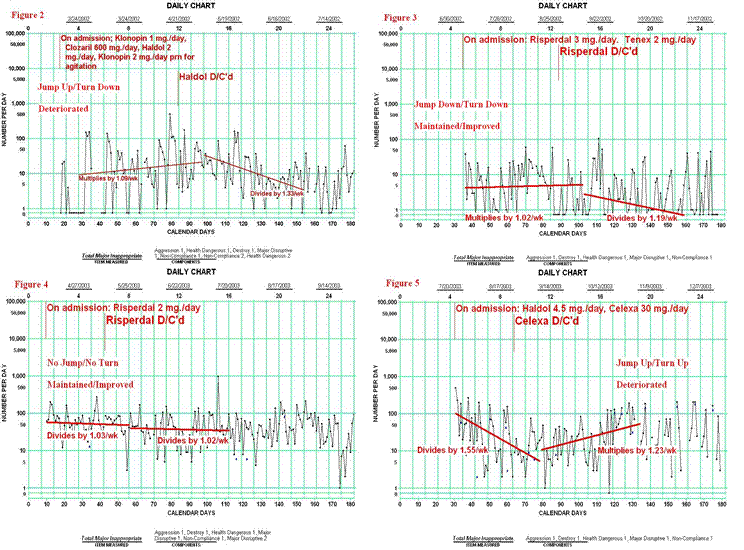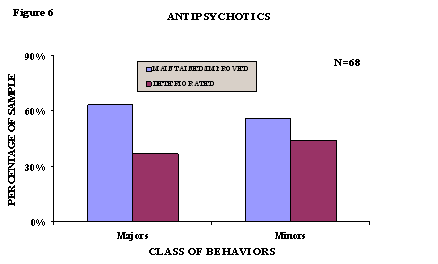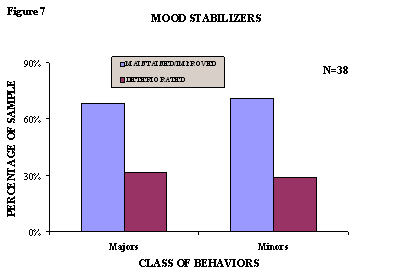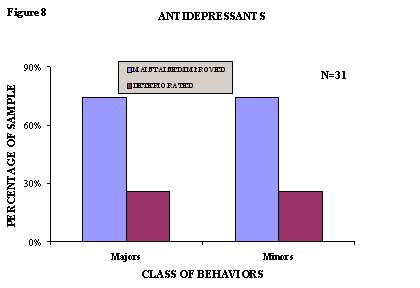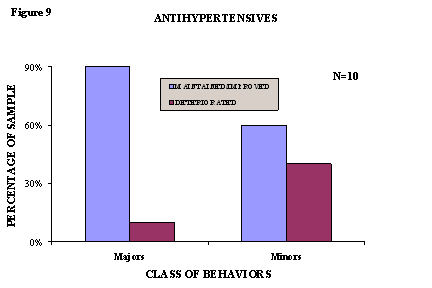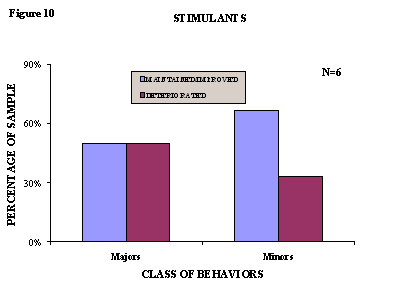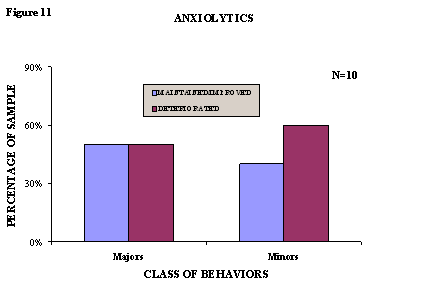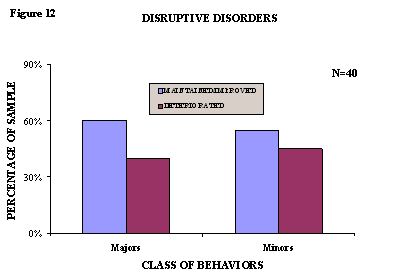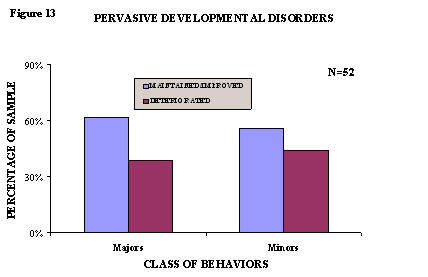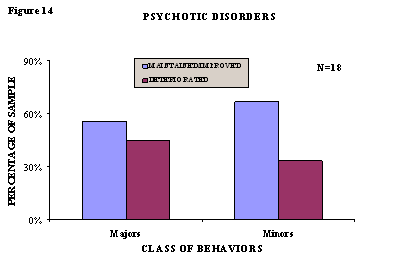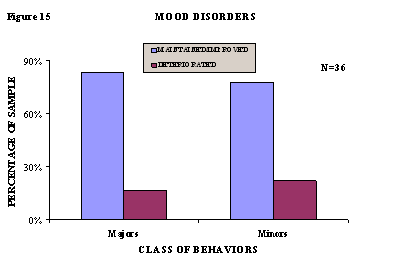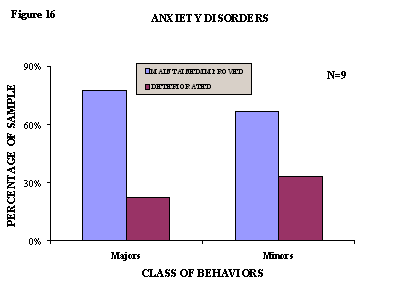Negative outcomes in studies of treatment effectiveness should call into question both the treatment practices and their underlying theories (Eysenck, 1994), yet treatments-as-usual persist. Psychotropic medications are widely used in community, residential and hospital settings as primary interventions for behavior problems, despite few empirical evaluations of their effectiveness when environmental sources of variance are rigorously controlled.
The Judge Rotenberg Center (JRC) provides a sample of opportunity permitting such evaluation in a setting that is comprehensively controlled in accordance with behavioral principles. The current study summarizes effects of psychotropic medication withdrawal for all students placed at JRC since 2001 while standardized behavioral treatment remained in effect.
If psychotropic medications are generally effective treatments for serious abnormal behavior, supportive evidence for their efficacy as well as for the underlying theories of biological psychiatry and antecedent diagnostic practice should be manifested in the form of observable increases in abnormal behavior following medication withdrawal. Conversely, the lack of such effects within a behaviorally engineered environment might challenge the necessity of psychopharmacologic treatment components or perhaps suggest equivalence of intervention strategies.
Method
Setting and Participants JRC is a near-zero reject, near-zero eject residential school that is run under radical behavioral principles. Students are generally ambulatory with a wide age and ability range. They are referred by school districts and state agencies serving children and individuals with developmental or psychiatric diagnoses and most study participants had been hospitalized prior to JRC admission (see Figure 1). Efforts are typically made to withdraw students from psychotropic medications.
During the period of study between November 2001 and April 2004, 79 JRC students were withdrawn from at least one psychotropic medication, had data available for at least four weeks before and after medication withdrawal, and were not concurrently under aversive program contingencies. Their mean age at the time of medication withdrawal was 16 yr, 4 mos. Primary and secondary DSM-IV-TR Axis I diagnoses of record were grouped into Disruptive Disorders (attention-deficit, conduct, oppositional, intermittent explosive disorders), Pervasive Developmental Disorders (autism-spectrum disorders), Psychotic Disorders (schizophrenia-spectrum disorders), Mood Disorders (bipolar, depressive, dysthymic disorders), and Anxiety Disorders (posttraumatic stress, generalized anxiety disorder). 36 (46%) were in the cognitively typical range (Full Scale IQ > 70).
Measures
Behavior Categories. Behavioral data for all students at JRC are gathered by 24-hour direct staff observation, marked on daily tally sheets divided into seven standard behavior categories. Aggression includes all physical aggression topographies defined for that student; Destroying includes all destruction of objects; Health Dangerous includes all self-injurious topographies defined for that student including leaving supervised areas and refusing necessary medical services; Major Disruptive includes swearing, encouraging peer misbehavior, stealing, arguing, provoking others and other individually defined violations of social norms; Noncompliance includes all refusals to perform assignments or requested tasks and violations of student rules. These five categories are termed Major Behaviors and are generally inclusive of conduct that resulted in the student’s admission to psychiatric facilities. The remaining two categories are termed Minor Behaviors. Inappropriate Verbal Behavior includes rude comments, negative comments, interruptions, nagging, inappropriate voice tone, slang, inappropriate or repetitive vocalizations and other individually defined vocal/verbal behaviors; Educationally-Socially Interfering Behavior includes stopping work (> 5 sec), non-functional, repetitive or stereotypic body movements, negative facial expressions or non-verbal gestures and other individually defined topographies. These behaviors are inclusive of behavior topographies (e.g., “stopping work,” “negative comments”) that may influence assignment of diagnostic labels or that could be expected to change with socially valid treatment outcomes. Each student’s daily sum of the five Major Behavior categories is plotted as Total Major Inappropriate, with the daily sum of the two Minor Behavior categories (generally significantly higher frequencies) plotted as Total Minor Inappropriate (see Figures 2 – 5).
Medication Withdrawal. The recorded date of the last dose of medication delivered was marked on participant charts as a labeled phase line for each psychotropic medication withdrawn (see Figures 2 – 5). With psychiatric consultation, medication withdrawal was defined as two weeks following the last dose of medication, to address clearance. Quartile intersect median trend lines were fitted to daily charts of Total Major Behaviors and Total Minor Behaviors for each participant for a minimum of 4 and maximum of 8 weeks preceding and a comparable period following medication withdrawal, for each psychotropic medication (see Figures 2 – 5).
Medication Withdrawal Effects. Each psychotropic medication withdrawal chart was scored as Maintained/Improved or Deteriorated. Charts were scored as Maintained/Improved if any of the following criteria were met: (a) the post medication withdrawal phases had a daily median of 0 and a celeration x 1.00; (b) there was a “turn down” (decrease in celeration) across phases with no “jump up” (abrupt increase in behavior rate); (c) there was no change in celeration (or an increase < 0.06) across phases and no jump up; there was a “jump down” (abrupt decrease in behavior rate) across phases with no “turn up” (increase in celeration). Charts were scored as Deteriorated if any of the following criteria were met: (a) there was a “turn up” (increase in celeration > 0.05) across phases, irrespective of “jump down” (unless post medication withdrawal phase had a median of 0 and celeration x 1.00); (b) there was a “jump up” across phases even with no change in celeration; (c) there was a “turn down” but also a “jump up” across phases. Figures 2-5 are examples of charts the show both deterioration and maintained/improved based on the criteria detailed above.
Results
Medication Classes. Figures 6 – 11 summarize the percentage of medication withdrawals within each medication class scored as Maintained/Improved or Deteriorated, for Major and Minor behavior charts. The number of medication withdrawals for each bar chart is indicated. Across all classes of psychotropic medication other than stimulants and anxiolytics, the majority of behavior charts were scored as Maintained/Improved.
Diagnostic Classifications. Figures 12 – 16 summarize the percentage of medication withdrawals within each DSM-IV-TR diagnostic grouping scored as Maintained/Improved or Deteriorated, for Major and Minor behavior charts. The number of medication withdrawals for each bar chart is indicated. Diagnostic classification appeared to have little differential effect on medication withdrawal. For each diagnostic category the majority of withdrawals of psychotropic medications were scored as Maintained/Improved.
Participant Age. Grouping participants by age (adults versus minors) did not affect the overall pattern of medication withdrawal effects.
Discussion
Several factors offset possible participant selection bias and maturation confounds. First, data used for the study were categories aggregated from operational definitions of the very difficulties that had led to participants’ previous psychiatric or residential treatment, and were behavior counts rather than ratings. Second, behavioral treatment (a combination of reward contingencies, contracts and token economy methods) was held constant. Third, environmental factors were held constant. JRC has achieved a high level of consistency in managing staff behavior, maintaining the physical environment, and delivery of programmatic services. This reduces the variance indirectly attributable to differing social responses to disruptive or disturbing student conduct. Fourth, very conservative scoring rules were adopted so that any visually salient increase in treated behavior after medication withdrawal was scored as Deteriorated.
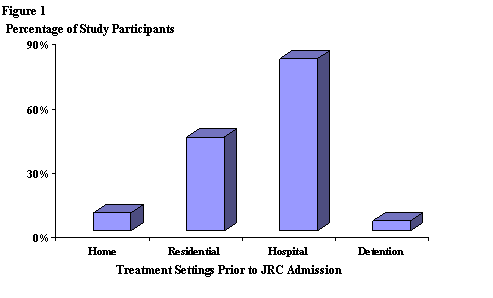
Within a controlled environment that provided consistent, behavioral treatment
and education, withdrawal of psychotropic medications had no discernable
adverse effect on behavior in a substantial majority of instances among this
predominantly adolescent sample. This finding applied irrespective of class
of psychotropic medication or diagnostic category. Although the opportunity
sample may limit inferences, it is evident that significant numbers of youth
and young adults with challenging behavior are prescribed psychotropic
medications despite limited empirically demonstrable effectiveness. The
current data also suggest few objections to the routine withdrawal of
psychotropic medications in a behavioral treatment environment, irrespective
of medication class or diagnostic classification.
References
Eysenck, H. J., (1994). The outcome problem in psychotherapy: What have we learned? Behavior Research and Therapy, 32, 477-495.
